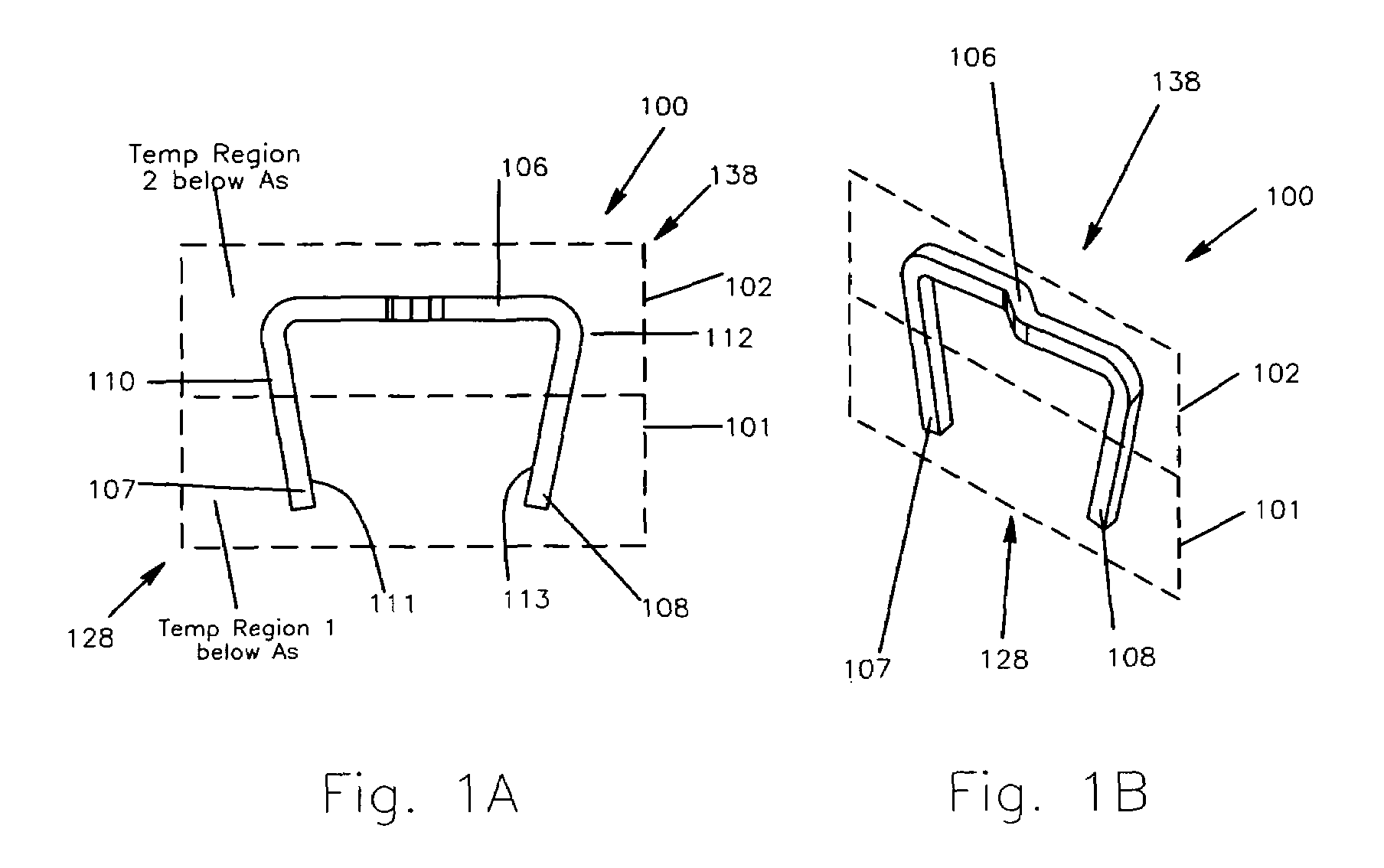Method and apparatus for a multiple transition temperature implant
a technology of transition temperature and implant, which is applied in the field of human body implants, can solve the problems of complex devices, no description of multiple transition temperatures in the same device, and large changes in the shape of the implant formed from memory metal
- Summary
- Abstract
- Description
- Claims
- Application Information
AI Technical Summary
Benefits of technology
Problems solved by technology
Method used
Image
Examples
first embodiment
[0095]In this alternative embodiment, the lower segments 161 and 163 are formed at a first transition temperature and the bridge 156 and upper segments 162 and 164 are formed at a second transition temperature. The lower segments 161 and 163 are then assembled together with the upper segments 162 and the bridge 156 to create the composite shape-memory device 150. In this specific example, the protrusions 167-168 are complementary in shape to the recesses 169-170, and of a size suitable for being press fit into a respective recess 169 or 170. Illustratively, the first protrusion 167 is press fit into the recess 169, and the second protrusion 168 is press fit into the recess 170, such that the contracting ends contract toward each other when moving from the second shape to the first shape, in similar fashion to the
[0096]FIG. 5D provides a flowchart illustrating the method steps for manufacturing the shape-memory device 150 according to this invention. The manufacturing process commenc...
second embodiment
[0099]In a second embodiment, a shape-memory device 200 includes a first portion 201 having multiple zones, and a second portion 202 having a single zone. As shown in FIG. 6A, the first portion 201 includes a first zone 204 and a second zone 205 that have a first shape 227 and a second shape 228, and a first transition temperature. The second shape 228 is shown in FIGS. 6A-6B while the first shape 227 is shown in FIGS. 7A-7B. The second portion 202 includes a second shape 238, shown in FIGS. 7A-7B, and a first shape 237, shown in FIGS. 8A-8B, and a second transition temperature. In this example, the shape-memory device 200 is a staple that may be utilized as a surgical implant, and includes a first leg 207, a second leg 208, a bridge 206, a first bend 210, and a second bend 211.
[0100]In this second embodiment, the first bend 210 is disposed between the first leg 207 and the bridge 206, and the second bend 211 is disposed between the second leg 208 and the bridge 206. The first bend ...
third embodiment
[0116]Manufacturing of the shape-memory device 300 that includes multiple layers for independent activation requires the separate formation of each layer in the respective first shape, independent heat treatment to create a shape-memory profile, and bonding of the layers together. Illustratively, in this third embodiment the first portion 301 and the second portion 302 are welded together along the outer edges. As previously disclosed, each layer includes a first shape and a second shape, and may be worked from the first shapes to second shapes, thereby creating the ability to move from the second shape to the first shape upon the application of activation energy. While this shape-memory device 300 has been shown with the first portion 301 and the second portion 302 welded together, one of ordinary skill in the art will recognize that any form of suitable connection may be utilized to bond the layers to one another, including mechanical fasteners, adhesive bonds, and the like.
[0117]...
PUM
 Login to View More
Login to View More Abstract
Description
Claims
Application Information
 Login to View More
Login to View More - R&D
- Intellectual Property
- Life Sciences
- Materials
- Tech Scout
- Unparalleled Data Quality
- Higher Quality Content
- 60% Fewer Hallucinations
Browse by: Latest US Patents, China's latest patents, Technical Efficacy Thesaurus, Application Domain, Technology Topic, Popular Technical Reports.
© 2025 PatSnap. All rights reserved.Legal|Privacy policy|Modern Slavery Act Transparency Statement|Sitemap|About US| Contact US: help@patsnap.com



